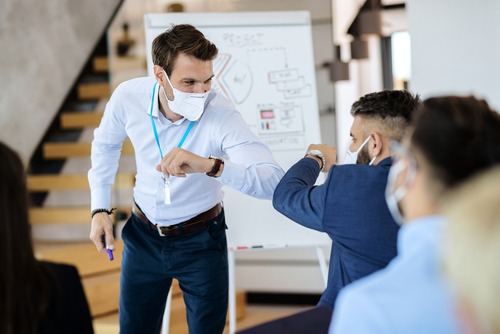
While scientific evidence shows it’s safe to return to large professional meetings and events (PMEs) in person, a new forecast signals a long road to recovery for business travel in the United States.
To speed up the process, companies should return to business travel and PMEs or risk getting squashed by an economic stumbling block, experts say.
“States with delayed reopenings must recognize they’re at a competitive disadvantage to those open for business, requiring focused efforts to encourage the safe return of both business and leisure travelers,” said U.S. Travel Association President and CEO Roger Dow. “Similarly, companies that continue to restrict business travel and attendance at in-person professional meetings and events will delay their own economic recovery and give their competitors an edge.”
Overall, business travel has a disproportionate impact on the U.S. travel economy, and despite making up 20 percent of total trip volume, business travelers account for 40 percent to 60 percent of all lodging and air revenue, according to Tori Barnes, executive vice president of public affairs and policy at the U.S. Travel Association.
“There is no substitute for conducting business in person and advancing ideas, making and enhancing connections, and revisiting the networks that we’ve relied on virtually for many months,” Barnes told Transportation Today in a recent interview. “These opportunities are as professionally productive as they are personally invigorating.”
Dow added that in-person PMEs “have been slow to return due to confusing and conflicting guidelines” released by the federal and state governments related to the ongoing COVID-19 pandemic.
The result is that corporate travel, PMEs, and conventions are expected to take at least four years to recover, according to a spring and summer 2021 United States travel spending forecast released by Tourism Economics and the U.S. Travel Association. Business travel spending is down 69 percent, according to the forecast, while spending related to meetings, conferences and events declined even further — down 76 percent.
Barnes pointed out that there is a distinct correlation between business travel and revenue and profitability, and cited a study by Oxford Economics, which found sectors that spent the most on business travel — even in cycles of economic downturn — tended to post higher growth in profits. A vast majority of companies surveyed for the study showed that reductions in business travel hurt their companies’ performance, while six in 10 business travelers said increased spending on business travel had a positive impact on company revenue and profits, he said.
“In terms of winning new business, business travelers say that prospects are twice as likely to become customers with an in-person meeting than without one,” said Barnes. “Simply put, in-person meetings provide a much-needed competitive advantage — and with the multiple layers of protection now in place for travel in general and for professional meetings and events specifically, these can be safely done.”
A new evidence-based analysis from public health scientists at The Ohio State University (OSU) concurs, calling PMEs “an integral part of business and organizational operations.”
“As the nation reopens following the first year of the pandemic, Americans are eager for a return to their pre-pandemic routines. For many, that includes business travel,” according to the OSU analysis. “It is important to recognize the value that PMEs provided prior to the outbreak and return to them as safely as possible to enhance career and occupational well-being, as well as to stimulate business and propel the economy forward.”
PMEs are controlled situations, such as conferences, trade shows and conventions, in which access is limited to registered guests. PMEs are supervised, so they allow for reliable applications of health and safety measures, including the appropriate use of facial coverings, pandemic-curated food and beverage services, hand sanitizing stations, and proactive steps to avoid overcrowding, such as physical distancing, according to the OSU analysis.
“Additionally, many PMEs maintain rapid response plans to manage potential illness or injury, including having health professionals on site, dedicating space to quarantine any infected or otherwise exposed individuals, and ensuring local healthcare facilities have enough excess capacity to treat affected attendees, as advised by the CDC,” the analysis says. “These attributes will remain important until we achieve uniform levels of full vaccination both nationally and internationally.”
The OSU public health experts who authored the analysis also noted that PMEs in which safety precautions have been observed have not been super-spreader events. “By setting standards to balance public health measures with meeting face to face, PMEs can help in a return to social interactions and networking,” they wrote. “As more of the population is fully vaccinated, these risks are further reduced.”
The analysis also provides evidence-based strategies that should be considered when organizing PMEs to reduce the risk of exposure to the coronavirus, including mask wearing, social distancing, disinfecting surfaces, providing proper ventilation and air flow, and providing pre-packaged meals and beverages.
“With nascent signs of business travel returning, we strongly urge Americans not to backslide in their return to professional life, especially with the multiple layers of protection that now exist at PMEs,” Barnes told Transportation Today. “These types of business events are distinct from other large, informal gatherings because they happen in controlled environments where health and safety controls are more readily implemented.”
As the nation continues to emerge from the pandemic, the ability to safely gather for business purposes has never been more important to economic rebuilding, said Dow.
“Employers and employees alike benefit from in-person meetings,” he said. “I urge business leaders across the country to take cues from the experts and lead the way, with confidence, in ushering business back through business travel and participation in professionally managed events.”
(Additional reporting by Terri Williams)